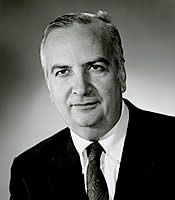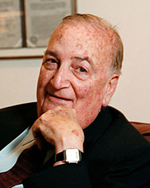Baruj Benacerraf, M.D.

Brief Bio
Baruj Benacerraf was born to Sephardic Jewish parents in Caracas, Venezuela, on October 29, 1920, he grew up in Paris, where his family lived until the threat of Second World War led them to return to Venezuela in the late 1930s. Although his parents hoped Baruj would follow in his father's footsteps and run the family textile business, he insisted on studying science at Columbia University, where he earned his B.S. in 1942. He applied to twenty-five medical schools, including several at which he later worked, but was rejected by all of them. Recalling his difficulty gaining admission, Benacerraf later in life reflected to the Boston Globe, "This country was strongly anti-Semitic in the 1940s. There were quotas. In addition, there was a tendency not to take in foreigners." With the help of a friend, he was admitted to the Medical College of Virginia in Richmond in 1943, the same year in which he became a naturalized U.S. citizen.
After completing his M.D. in 1945, Benacerraf interned at Queens General Hospital in New York and served in the U.S. Army Medical Corps in France for two years before beginning his training in immunology as an unpaid research fellow in Elvin Kabat's (AAI '43, president 1965–66) laboratory at the Neurological Institute of Columbia University Medical Center in 1948. He reportedly chose immunology because he had suffered from asthma as a child and wanted to find out why the body sometimes responds so drastically to allergens.
Benacerraf moved to Broussais Hospital in Paris to work in the immunology lab of Bernard Halpern, the discoverer of antihistamines, in 1949. He returned to the United States in 1956 and accepted a position as professor of pathology at New York University School of Medicine, where he conducted his pioneering research. He directed the immunology laboratory at the National Institute of Allergy and Infectious Diseases from 1968 to 1970. Desiring a return to academic life, he accepted an appointment as chair of the Department of Comparative Pathology at Harvard Medical School in 1970. In 1980, he left Harvard to serve as president and CEO of the Dana-Farber Cancer Institute, a position he held until his retirement in 1991.
Benacerraf shared a love of the arts with his wife, Annette Dreyfus, whom he married in 1943. In addition to collecting art and regularly attending the theater, the couple enjoyed classical music and often performed duets for friends, with Baruj on flute and Annette on harpsichord.
Benacerraf died on August 2, 2011, at his home in Jamaica Plain, Massachusetts, at the age of 90.
Nobel Prize in Physiology or Medicine
1980 Nobel Prize in Physiology or Medicine jointly with
Jean Dusset (AAI '74) and George Snell for their independent discoveries of “genetically determined structures on the cell surface that regulate immunological reactions”
AAI Service History
Joined: 1957
President: 1973–1974
Vice President: 1972–1973
Councillor: 1968–1972
The Journal of Immunology
Associate Editor: 1968–1977
Editorial Board: 1972–1979
Committees
Ad hoc Steering Committee for International Congress: 1968–1969
First International Congress of Immunology Organizing Committee: 1970–1972
Ad hoc Committee on Public Relations: 1972–1973
Awards Committee: 1977–1978 (chair)
Finance Committee: 1981–1984 (co-chair)
Nominating Committee: 1985–1986 (chair)
Public Affairs Committee: 1989–1991
Other Service
AAI Representative to FASEB Board: 1972–1975
AAI Representative to FASEB Executive Committee: 1972–1975
Nobel Prize in Science
Baruj Benacerraf was awarded the 1980 Nobel Prize in Physiology or Medicine jointly with George Snell and Jean Dausset (AAI '75) for their pioneering studies on the major histocompatibility complex (MHC). Benacerraf demonstrated that genetic factors regulate an individual's immune responses. This discovery shed light on the association of certain autoimmune diseases with particular MHC antigens and the variations in individuals' abilities to respond to pathogens and cancers.
The immune response (Ir) genes discovered by Benacerraf were found to map within the MHC and were subsequently shown to code for MHC class II molecules. The discovery of Ir genes provided the basis for the finding by several laboratories that the presentation of antigen to T cell and the interactions of T and B cells are "restricted" by the MHC.
Among his many contributions to the field of immunology, Benacerraf also helped develop our understanding of the phagocytic activity of macrophages, described the functions of IgG subclasses, discovered Fc receptors, demonstrated that T and B cells recognize antigens differently, and observed how B and T cells cooperate with each other to generate an antibody response. Benacerraf helped elucidate the relationship between allorecognition and the T cell response to foreign antigens presented by self-MHC molecules, and he was among the first to study suppressor T cells.
According to colleagues Ronald Germain (AAI '78) and Steven Burakoff (AAI '78), Benacerraf helped bring the "disparate themes in immunology under a single conceptual framework."
President's Address
"
The Training Experience," Delivered April 10, 1974
The Journal of Immunology 113, no. 2 (1974): 431–37.
Awards and Honors
- Member, American Academy of Arts and Sciences, 1971
- Member, National Academy of Sciences, 1973
- Rabbi Shai Shacknai Prize in Immunology and Cancer Research, Hebrew University in Jerusalem, 1974
- T. Duckett Jones Memorial Award, Helen Hay Whitney Foundation, 1976
- Nobel Prize in Physiology or Medicine, 1980
- Waterford Biomedical Science Award, 1980
- Member, Institute of Medicine, 1982
- National Medal of Science, 1990
- Gold-Headed Cane Award, American Society of Investigative Pathology, 1996
- Charles A. Dana Award for Pioneering Achievements in Health, 1996
- AAI Excellence in Mentoring Award, 2001
Institutional/Biographical Links
AAI In Memoriam

Baruj Benacerraf
Nobel laureate (1980) and past AAI president (1973) Baruj Benacerraf, M.D. (AAI '57), died on August 2, 2011, at the age of 90. Benacerraf served as AAI president in 1973 and as a member of the AAI Council from 1968-1975. He was a member of various AAI committees, including the Committee on Public Affairs (1989-91), ad hoc Steering Committee for the International Congress (1968-69), First International Congress of Immunology Committee (1970-71), and ad hoc Committee on Public Relations (1972-73). Benacerraf served from 1968-72 as an associate editor for The Journal of Immunology (The JI) and was a member of The JI Editorial Board from 1972-79. The 2001 AAI Excellence in Mentoring Award honoree, Benacerraf was an AAI Plenary Lecturer at the 1980 AAI Annual Meeting and was one of four featured speakers for the special 75th AAI Anniversary Symposium, "Immunology in Perspective," at the 1988 AAI Annual Meeting. An AAI tribute authored by Ron Germain and Steve Burakoff, capturing the remembrances of many colleagues, was published in The Journal of Immunology and appeared in the October-November 2011 issue of the AAI Newsletter. For highlights of Benacerraf's AAI service and career achievements, visit his profile in the History section of the AAI site.